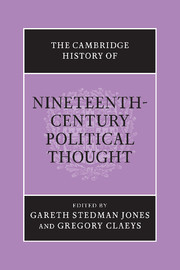Book contents
- Frontmatter
- Contents
- Contributors
- Acknowledgements
- Introduction
- I Political thought after the French Revolution
- II Modern liberty and its defenders
- III Modern liberty and its critics
- IV Secularity, reform and modernity
- 18 Church and state: the problem of authority
- 19 The politics of nature
- 20 Conservative political thought from the revolutions of 1848 until the fin de siècle
- 21 Modern liberty redefined
- 22 Political economy
- 23 German socialism and social democracy 1860 –1900
- 24 Russian political thought of the nineteenth century
- 25 European political thought and the wider world during the nineteenth century
- 26 Empire and imperialism
- Epilogue
- Biographies
- Bibliography
- Index
21 - Modern liberty redefined
from IV - Secularity, reform and modernity
Published online by Cambridge University Press: 28 July 2011
- Frontmatter
- Contents
- Contributors
- Acknowledgements
- Introduction
- I Political thought after the French Revolution
- II Modern liberty and its defenders
- III Modern liberty and its critics
- IV Secularity, reform and modernity
- 18 Church and state: the problem of authority
- 19 The politics of nature
- 20 Conservative political thought from the revolutions of 1848 until the fin de siècle
- 21 Modern liberty redefined
- 22 Political economy
- 23 German socialism and social democracy 1860 –1900
- 24 Russian political thought of the nineteenth century
- 25 European political thought and the wider world during the nineteenth century
- 26 Empire and imperialism
- Epilogue
- Biographies
- Bibliography
- Index
Summary
Introduction
This chapter is devoted to British liberalism in the latter part of the nineteenth century. These years have commonly been viewed as an era of transition. Mid-Victorian liberalism has been widely seen as individualistic, and suspicious of state intervention. The close of the century, however, saw the emergence of a new liberalism, which departed from the earlier individualism, and advocated an enhanced role for state action.
The historiography of new liberalism has been much informed by contemporary political and theoretical concerns. It has been suggested that the presumed dichotomy between liberalism and communitarianism in recent political theory can be transcended through the examination of the new liberal reconciliation of the two (Simhony and Weinstein 2001). Similar claims have been made for new liberalism as a fruitful marriage of liberal and social democratic priorities (Clarke 1978). Later nineteenth–century liberalism, including the later Mill, has been depicted as a powerful fusion of liberal and republican perspectives (Biagini 2003).
- Type
- Chapter
- Information
- The Cambridge History of Nineteenth-Century Political Thought , pp. 720 - 747Publisher: Cambridge University PressPrint publication year: 2011



